The objective of our program is to protect and promote the recovery of the Mediterranean Monk Seal colony which is located on the coast of the Cap Blanc Peninsula in Mauritania. The following is a brief description of the animal that we work with.
The Mediterranean Monk Seal is one of the ten species of mammals most at risk of extinction around the world. It belongs to a group known as the pinnipeds, which also includes marine species of sea lions, fur seals and walrus. Seals as a group may, in turn, be classified into two sub-groups: northern seals, a set of ten species that live mainly in the Arctic and Sub-Arctic zones, and the seals in the monachinae group, which include the species that live in the Antarctic and in sub-tropical regions. This is where we find the genus monachus, to which the Mediterranean Monk Seal belongs.
The monachus genus contains, since 2015, only one species and is, with the species of the genus Neomonachus, considered to be the most ancient of all known Phocidae, or “true seals”:

NEOMONACHUS
- The Caribbean monk seal, or Neomonachus tropicalis: It was given up for extinct in the fifties. Hunting for its fur, meat and oil practically since the Americas were discovered led to its extinction five centuries later.
- The Hawaiian monk seal, or Neomonachus schauinslandi: This is a species endemic to the Hawaiian Islands. Although there are approximately 1,400 individuals, its population has fallen by 60% over the last 60 years.
- The Mediterranean Monk Seal, or Monachus monachus: Normally this species is related with the Mediterranean Sea, but it also inhabits the eastern part of the Atlantic Ocean, where it can be found in the Seal Coast Reserve where we perform conservation, on the Cap Blanc Peninsula in Mauritania. In fact, it is calculated that half of the entire world population inhabits this area. The Mediterranean Monk Seal is considered to be in danger of extinction, and there are no more than 700 animals living throughout its entire area of distribution.
MONACHUS
Characteristics of the Mediterranean monk seal
- Size: It is the largest of the phocidae after the elephant seals. The males may come to weigh as much as 300 kg and measure as much as 2.80 m. The females are somewhat smaller. When born, the offspring measure approximately 1 m.
- Fur: They are born with black fur and a white spot on their stomach, with a pattern of black spots that is unique and exclusive to each animal, with differences between male and female offspring (the lower part of it is straight on females and curved on males). They maintain this fur until the age of approximately two months. At this time, when they first molt, their fur turns to a gray color, and the ventral spot is covered up, with only its outline remaining visible. The adult females remain a gray color. However, the male adults are distinguished from the remaining members of the population because they regain the fur of the offspring.
- Habitat: Centuries ago, the monk seal lived in large colonies on sand bars and open-air beaches. However, due to the destruction of this type
- of habitat, and the persecution and disturbances they have suffered, they currently gather in inaccessible hidden caves.
- Diet and foods: Their diet is varied and includes fish, crustaceans and cephalopods. The females only fast during the first days of their offspring’s’ life, then delving into the high seas in search of food. Lactation of the offspring lasts for up to four months.
- Offspring: The females may have their first pup at three years of age. They normally have one offspring per year, with the breeding period in Cap Blanc beginning in April and ending in November.
- Distribution: There are two clearly differentiated zones, the population which is located in Greece and Turkey, estimated at approximately 350 seals, and the Atlantic population, which has approximately 40 seals in Madeira and over 330 on the Cap Blanc Peninsula. The Mediterranean population is considered to be stable and the Atlantic population to be undergoing growth.
History
 1436 Afonso Gonçalves Baldaia, one of the first Portuguese sailors to cross Cape Bojador, considered the end of the world up to that time, brings back stories of thousands of sea wolves, or monk seals, on sand bars in the Rio de Oro (Sahara). So began the era of exploiting the monk seal colonies in the Atlantic for their fur, as well as their blubber for making oil. This hunting would last until the twentieth century.
1436 Afonso Gonçalves Baldaia, one of the first Portuguese sailors to cross Cape Bojador, considered the end of the world up to that time, brings back stories of thousands of sea wolves, or monk seals, on sand bars in the Rio de Oro (Sahara). So began the era of exploiting the monk seal colonies in the Atlantic for their fur, as well as their blubber for making oil. This hunting would last until the twentieth century. 
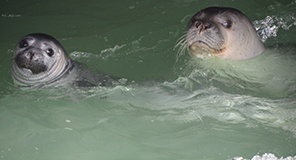 1923 After the seals had been decimated to near extinction, French explorer Theodore Monod unsuccessfully attempts to locate a surviving monk seal colony on the Cap Blanc Peninsula. There are a few sightings of some animals in the water, and he finds the remains of dead seals, but not their mating areas.
1923 After the seals had been decimated to near extinction, French explorer Theodore Monod unsuccessfully attempts to locate a surviving monk seal colony on the Cap Blanc Peninsula. There are a few sightings of some animals in the water, and he finds the remains of dead seals, but not their mating areas. 
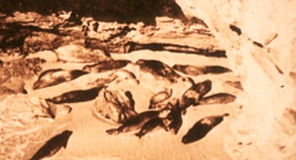 1945 While studying Saharan locust plagues, Spanish naturalist Eugenio Morales Agacino finds the monk seal colony on the Cap Blanc Peninsula, in the area known from then on as the “Seal Coast.” He sees groups of animals resting on open-air beaches, having just found the last surviving colony on the entire African coast.
1945 While studying Saharan locust plagues, Spanish naturalist Eugenio Morales Agacino finds the monk seal colony on the Cap Blanc Peninsula, in the area known from then on as the “Seal Coast.” He sees groups of animals resting on open-air beaches, having just found the last surviving colony on the entire African coast. 

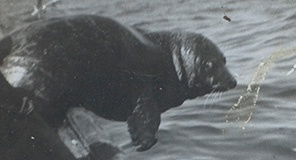 Segunda mitad del Siglo XX The Cap Blanc Peninsula is located in one of the most productive fishing grounds in the world. Throughout the second half of the twentieth century, fishing work in the area never ceases to increase. It is believed that hunting by fishermen and accidental captures in fishing nets are devastating to the seal population.
Segunda mitad del Siglo XX The Cap Blanc Peninsula is located in one of the most productive fishing grounds in the world. Throughout the second half of the twentieth century, fishing work in the area never ceases to increase. It is believed that hunting by fishermen and accidental captures in fishing nets are devastating to the seal population. 
 1975-1991 War of the Sahara. Decolonization of the Spanish Sahara leads to an armed conflict in the area which makes it impossible to visit the colony for many years.
1975-1991 War of the Sahara. Decolonization of the Spanish Sahara leads to an armed conflict in the area which makes it impossible to visit the colony for many years. 
 1984 Didier Marchessaux, a French researcher, begins to study the species on the Cap Blanc Peninsula. He explores the seal coast and locates animals from the colony which has found refuge in a small number of caves.
1984 Didier Marchessaux, a French researcher, begins to study the species on the Cap Blanc Peninsula. He explores the seal coast and locates animals from the colony which has found refuge in a small number of caves. 
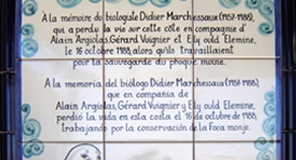 1989 Didier Marchessaux, Alain Argiolas, Gérard Vuignier and Ely Ould Elemine die tragically when their all-terrain vehicle passes over an anti-tank mine left over from the Saharan War on the Seal Coast. A plaque is currently in place at the Biological Station of “Las Cuevecillas,” located over the breeding caves, to pay homage to their work.
1989 Didier Marchessaux, Alain Argiolas, Gérard Vuignier and Ely Ould Elemine die tragically when their all-terrain vehicle passes over an anti-tank mine left over from the Saharan War on the Seal Coast. A plaque is currently in place at the Biological Station of “Las Cuevecillas,” located over the breeding caves, to pay homage to their work. 
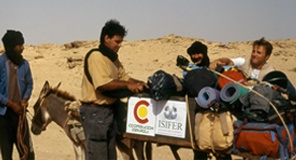 1993 After a few years of abandonment, a group of Spanish conservationists and researchers led by Luis Mariano González and Luis Felipe López Jurado carry out an expedition to the Seal Coast. They once again find the population’s breeding caves and begin to work permanently in the area.
1993 After a few years of abandonment, a group of Spanish conservationists and researchers led by Luis Mariano González and Luis Felipe López Jurado carry out an expedition to the Seal Coast. They once again find the population’s breeding caves and begin to work permanently in the area. 
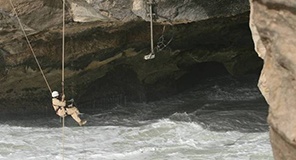 1994 The Spanish teams build a small camp in the area and set up video surveillance cameras in the colony’s two main breeding caves. From then on, they begin to discover aspects about the species’ biology which were completely unknown up to then.
1994 The Spanish teams build a small camp in the area and set up video surveillance cameras in the colony’s two main breeding caves. From then on, they begin to discover aspects about the species’ biology which were completely unknown up to then. 
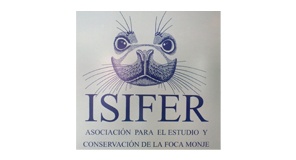 1995-1998 The Spanish teams begin a LIFE project to study the possibility of reintroducing monk seal individuals into the Canary Islands. At the time, the seal population is estimated to be 350, over 50% of the entire world population.
1995-1998 The Spanish teams begin a LIFE project to study the possibility of reintroducing monk seal individuals into the Canary Islands. At the time, the seal population is estimated to be 350, over 50% of the entire world population. 
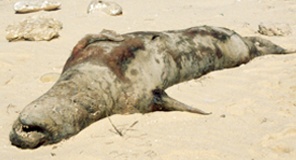 1997 Massive mortality is caused by toxic algae which decimates the seal population. Over 100 adult cadavers are found on the beaches of the Cap Blanc Peninsula. It is estimated that only 109 seals have survived, most of which are young adults and juveniles. The hopes for the species’ recovery at the worldwide level based on this colony are dashed.
1997 Massive mortality is caused by toxic algae which decimates the seal population. Over 100 adult cadavers are found on the beaches of the Cap Blanc Peninsula. It is estimated that only 109 seals have survived, most of which are young adults and juveniles. The hopes for the species’ recovery at the worldwide level based on this colony are dashed. 
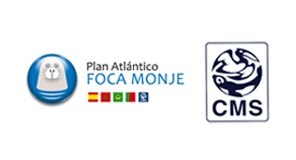 1999 At the scientific board of the Convention of Migratory Species (CMS/UNEP), Luis Mariano González, representing Spain’s Environment Ministry, proposes the drafting of an International Action Plan for recovery of the Mediterranean Monk Seal in the Eastern Atlantic. The proposal is accepted, and the Spanish Environment Ministry begins to work with the representatives from Morocco, Mauritania and Portugal.
1999 At the scientific board of the Convention of Migratory Species (CMS/UNEP), Luis Mariano González, representing Spain’s Environment Ministry, proposes the drafting of an International Action Plan for recovery of the Mediterranean Monk Seal in the Eastern Atlantic. The proposal is accepted, and the Spanish Environment Ministry begins to work with the representatives from Morocco, Mauritania and Portugal. 
 2000 The first meeting of the Action Plan for Recovery of the Monk Seal in the Eastern Atlantic is held in Las Palmas de Gran Canaria, with representatives from Morocco, Mauritania, Portugal and Spain. The path towards the colony’s preservation is begun.
2000 The first meeting of the Action Plan for Recovery of the Monk Seal in the Eastern Atlantic is held in Las Palmas de Gran Canaria, with representatives from Morocco, Mauritania, Portugal and Spain. The path towards the colony’s preservation is begun. The CBD-Habitat Foundation picks up where the LIFE project left off in 1998 and begins to work on the Cap Blanc Peninsula within the framework of the Action Plan, with the sole objective of recovering the monk seal population on the Seal Coast.

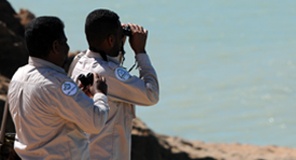 2001 The CBD-Habitat Foundation and the local NGO Annajah create the participatory “Seal Coast” reserve along with artisanal fishermen and regional authorities to protect the colony’s breeding caves and their surrounding areas. As of this moment, a surveillance system is created which eliminates the nets cast in the area and the disturbances caused in the breeding caves by barnacle collectors and fishermen. The reserve gradually protects 6 kilometers of coastline along which caves used by the seals are found.
2001 The CBD-Habitat Foundation and the local NGO Annajah create the participatory “Seal Coast” reserve along with artisanal fishermen and regional authorities to protect the colony’s breeding caves and their surrounding areas. As of this moment, a surveillance system is created which eliminates the nets cast in the area and the disturbances caused in the breeding caves by barnacle collectors and fishermen. The reserve gradually protects 6 kilometers of coastline along which caves used by the seals are found. 
 2002-2005 At the same time as the reserve’s surveillance, numerous development cooperation activities are carried out with a focus mainly on improving the living and working conditions of the artisanal fishermen of the Cap Blanc Peninsula. A market is built for selling fish. Many training courses are held on safety at sea and repairing off-board motors. Safety materials are given out, training on responsible fishing is provided, etc.
2002-2005 At the same time as the reserve’s surveillance, numerous development cooperation activities are carried out with a focus mainly on improving the living and working conditions of the artisanal fishermen of the Cap Blanc Peninsula. A market is built for selling fish. Many training courses are held on safety at sea and repairing off-board motors. Safety materials are given out, training on responsible fishing is provided, etc. 
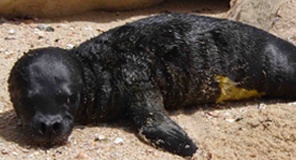 2006 The number of pups born in the Sea Coast caves increases from an average of 26 pups per year in the period of 2001-2005 to 48 pups. The conservation work begins to show results. The population enters a phase of recovery.
2006 The number of pups born in the Sea Coast caves increases from an average of 26 pups per year in the period of 2001-2005 to 48 pups. The conservation work begins to show results. The population enters a phase of recovery. 
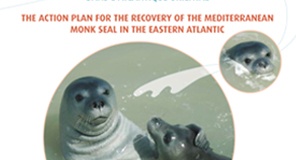 2007 The Memorandum of Understanding (MoU) of the Action Plan is signed in Tenerife, Spain, by the Environment Minister of Spain, the Fishing Minister of Mauritania, the Fishing Minister of Morocco and the Environment Minister of Portugal.
2007 The Memorandum of Understanding (MoU) of the Action Plan is signed in Tenerife, Spain, by the Environment Minister of Spain, the Fishing Minister of Mauritania, the Fishing Minister of Morocco and the Environment Minister of Portugal. 
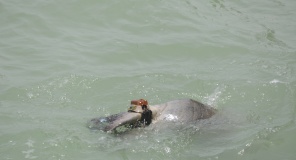 2007 Experts from CBD-Habitat develop a non-invasive system of tagging via satellite by placing bracelets on the back fins of the seals while they are asleep. We begin to become familiar with the seal’s movements at sea, completely unknown up to then, which constitutes one of the main disadvantages in improving protection of the colony.
2007 Experts from CBD-Habitat develop a non-invasive system of tagging via satellite by placing bracelets on the back fins of the seals while they are asleep. We begin to become familiar with the seal’s movements at sea, completely unknown up to then, which constitutes one of the main disadvantages in improving protection of the colony. 
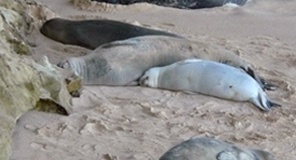 2008 The open-air beaches in the Seal Coast Reserve are being used more and more by the seals. After centuries of hunting, the tranquility offered by their constant surveillance allows that they have begun recovering their original habitats.
2008 The open-air beaches in the Seal Coast Reserve are being used more and more by the seals. After centuries of hunting, the tranquility offered by their constant surveillance allows that they have begun recovering their original habitats. 
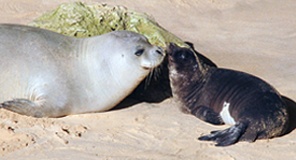 2009 Sofia is born. For the first time in many decades, a female gives birth on an open-air beach. This is made possible by the protection which has been provided in recent years along the Seal Coast.
2009 Sofia is born. For the first time in many decades, a female gives birth on an open-air beach. This is made possible by the protection which has been provided in recent years along the Seal Coast. 
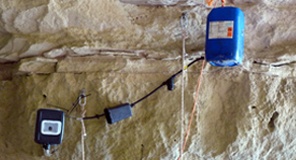 2010 In order to determine the use or potential re-colonization of other sites by the seals, we begin to install photo-trap cameras in remote areas and sites which are difficult to access. To do so, experts from the CBD-Habitat Foundation develop an automatic, autonomous camera lens cleaning system that allows operation of the cameras for long periods of time, minimizing the need to access these sites.
2010 In order to determine the use or potential re-colonization of other sites by the seals, we begin to install photo-trap cameras in remote areas and sites which are difficult to access. To do so, experts from the CBD-Habitat Foundation develop an automatic, autonomous camera lens cleaning system that allows operation of the cameras for long periods of time, minimizing the need to access these sites. 
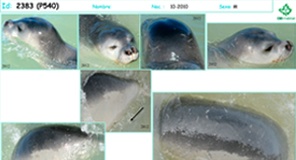 2011 The seal population grows to over 220 individuals, 73 of which are individually classified reproducing females. Since 1988, the population has doubled.
2011 The seal population grows to over 220 individuals, 73 of which are individually classified reproducing females. Since 1988, the population has doubled. 
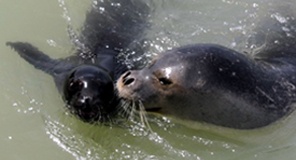 2012 For the first time, the complete tracking of animals identified at birth and until they reach sexual maturity is achieved. This makes it possible to obtain demographic figures of key importance for tracking the population: first reproduction date, mortality rates in different age categories, etc.
2012 For the first time, the complete tracking of animals identified at birth and until they reach sexual maturity is achieved. This makes it possible to obtain demographic figures of key importance for tracking the population: first reproduction date, mortality rates in different age categories, etc. A new record is achieved, with the detection of 63 new pups throughout this year.

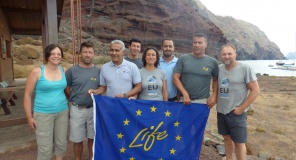 2014 The mediterranean monk seal program starts a LIFE project at the archipelago of Madeira.
2014 The mediterranean monk seal program starts a LIFE project at the archipelago of Madeira. www.lifemadeiramonkseal.com

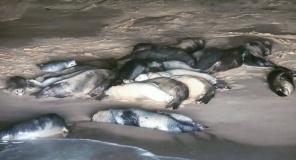 2015 Thanks to conservation efforts, the Mediterranean monk seal is downlisted from critically endangered to endanged on the red list of endangered species of the UICN.
2015 Thanks to conservation efforts, the Mediterranean monk seal is downlisted from critically endangered to endanged on the red list of endangered species of the UICN. http://www.iucnredlist.org/details/13653/0

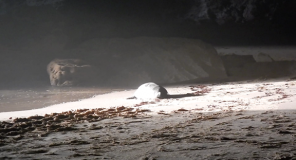 2015 Neomonachus: New Genus of Monk Seals Described. Since 2015, the Mediterranean monk seal is the sole species of the genus Monachus
2015 Neomonachus: New Genus of Monk Seals Described. Since 2015, the Mediterranean monk seal is the sole species of the genus Monachus http://www.sci-news.com/biology/science-neomonachus-new-genus-monk-seals-01945.html

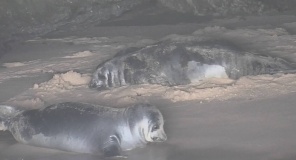 2016 The number of pups born in the Sea Coast caves reaches a new record. 82 pups!!
2016 The number of pups born in the Sea Coast caves reaches a new record. 82 pups!! 
 2017 ¡¡¡Seal on 4K!!! A new monitoring system helps us to control the seal colony.
2017 ¡¡¡Seal on 4K!!! A new monitoring system helps us to control the seal colony. 


Results
In the year 2000, the CBD-Habitat Foundation began to work on the Cap Blanc Peninsula, as part of the Action Plan for Conservation of the Mediterranean Monk Seal in the Eastern Atlantic (CMS/UNEP), with the sole objective of recovering the monk seal population on the Seal Coast in Mauritania.
Since then, two important achievements have been made:
Demographic recovery of the population.
At the present time, this population is fully undergoing growth. After the creation of the Seal Coast Reserve, the number of seals has gradually increased year by year, rising from the estimated 100 individuals in 1998 to the current population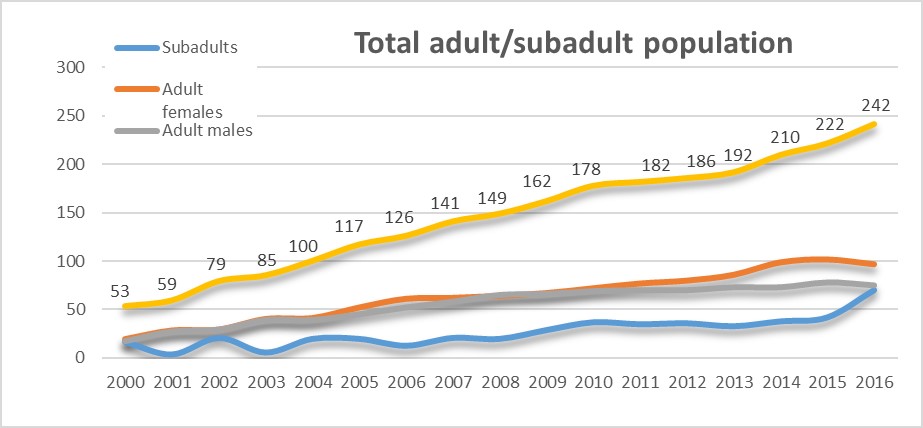
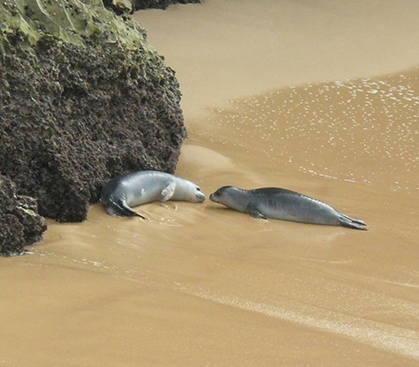
Protection of the breeding caves and their surrounding areas by creating the Seal Coast Reserve.
Thanks to the surveillance which we perform in the land and sea areas of the reserve to prevent the placement of nets and the presence of fishermen and barnacle collectors on land, we have managed to keep the protected area safe and eliminate threats and disturbances in the breeding caves. This has contributed to the fact that there are fewer deaths of seals caught in nets, the available food has increased, and the seals feel safe enough to recover their original habitat gradually. They are even beginning to use the open-air beaches located inside of the reserve.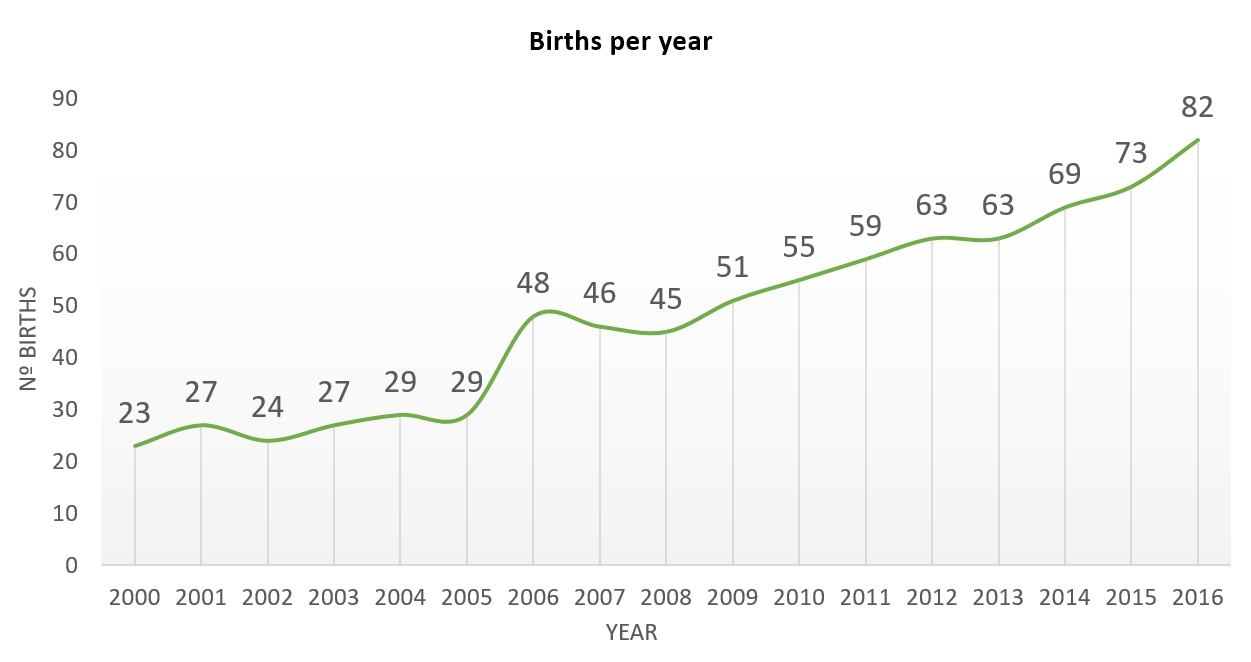

Fishing gears detected in and out the reserve
Data taken from the marine surveillance